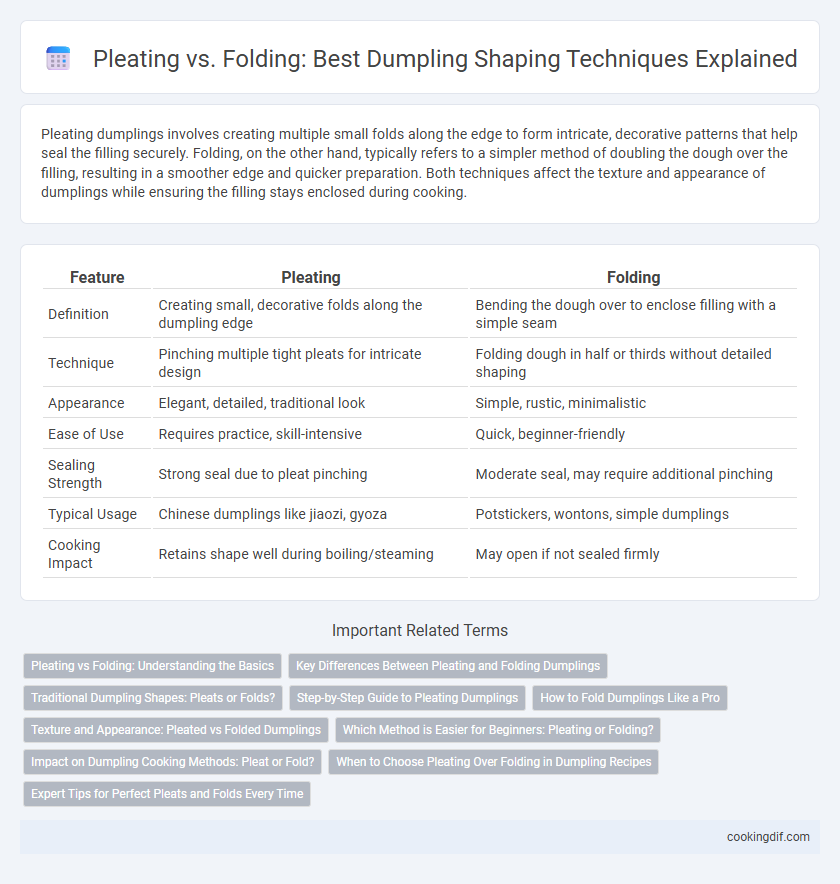Pleating dumplings involves creating multiple small folds along the edge to form intricate, decorative patterns that help seal the filling securely. Folding, on the other hand, typically refers to a simpler method of doubling the dough over the filling, resulting in a smoother edge and quicker preparation. Both techniques affect the texture and appearance of dumplings while ensuring the filling stays enclosed during cooking.
Table of Comparison
| Feature | Pleating | Folding |
|---|---|---|
| Definition | Creating small, decorative folds along the dumpling edge | Bending the dough over to enclose filling with a simple seam |
| Technique | Pinching multiple tight pleats for intricate design | Folding dough in half or thirds without detailed shaping |
| Appearance | Elegant, detailed, traditional look | Simple, rustic, minimalistic |
| Ease of Use | Requires practice, skill-intensive | Quick, beginner-friendly |
| Sealing Strength | Strong seal due to pleat pinching | Moderate seal, may require additional pinching |
| Typical Usage | Chinese dumplings like jiaozi, gyoza | Potstickers, wontons, simple dumplings |
| Cooking Impact | Retains shape well during boiling/steaming | May open if not sealed firmly |
Pleating vs Folding: Understanding the Basics
Pleating and folding are two distinct techniques used in shaping dumplings, with pleating involving multiple small, precise folds along the edge to create a decorative, textured pattern that helps seal the dumpling tightly. Folding typically refers to a simpler method where the dough is folded in half over the filling without intricate detailing, resulting in a smoother edge. Mastering pleating enhances dumpling aesthetics and ensures even cooking, while folding offers a quicker, more straightforward approach for dumpling preparation.
Key Differences Between Pleating and Folding Dumplings
Pleating dumplings involves creating multiple small, decorative folds along the edge of the wrapper, enhancing both the texture and appearance, which helps seal the filling tightly and prevents leakage during cooking. Folding dumplings typically means simply folding the wrapper in half or into a basic shape without intricate details, resulting in a more straightforward seal and a different bite experience. Pleated dumplings often showcase craftsmanship and provide a chewier, layered texture, while folded dumplings are quicker to make and emphasize ease and uniformity.
Traditional Dumpling Shapes: Pleats or Folds?
Traditional dumpling shapes predominantly feature pleats, which create intricate ridges that enhance texture and improve structural integrity during cooking. Folding techniques, while simpler, yield a smooth edge that emphasizes a minimalist aesthetic and is easier for beginners to master. The choice between pleats or folds influences not only the dumpling's appearance but also its ability to hold filling and absorb sauces, making pleating a hallmark of authentic Asian dumpling craftsmanship.
Step-by-Step Guide to Pleating Dumplings
Pleating dumplings involves carefully pinching the edges of the wrapper into small folds to create a decorative, sealed edge that holds filling securely and enhances cooking texture. Begin by placing a small amount of filling in the center of the wrapper, then fold the wrapper in half, pinching one edge while forming uniform pleats along one side to ensure tight sealing. This method preserves the dumpling's shape and helps distribute heat evenly during cooking, resulting in a tender, flavorful bite.
How to Fold Dumplings Like a Pro
Master the art of folding dumplings like a pro by using precise pleating techniques that create uniform, sealed edges to prevent filling leakage during cooking. Start with a thin, round dough wrapper, place the filling in the center, then fold the wrapper in half and pinch the edges while making consistent pleats along one side to create a crescent shape. Practicing this method results in visually appealing dumplings with a perfect texture and enhanced flavor retention.
Texture and Appearance: Pleated vs Folded Dumplings
Pleated dumplings create a textured surface with fine, intricate ridges that enhance visual appeal and provide a slightly chewier bite, contributing to a more complex mouthfeel. Folded dumplings exhibit a smoother, simpler exterior that results in a softer texture and highlights the dumpling's filling more prominently. The choice between pleating and folding impacts both the aesthetic elegance and the tactile experience of traditional dumplings such as Chinese jiaozi or Japanese gyoza.
Which Method is Easier for Beginners: Pleating or Folding?
Folding dumplings involves simple, straightforward creases that are easier for beginners to master, requiring less precision and time compared to pleating. Pleating demands skillful, repetitive pinching of dough edges to create intricate patterns, which can be challenging for novice cooks. For those new to dumpling making, folding offers a faster and more accessible way to achieve consistent, functional shapes.
Impact on Dumpling Cooking Methods: Pleat or Fold?
Pleating dumplings creates a thicker, more textured edge that holds fillings securely, making them ideal for steaming and boiling where the wrapper needs to withstand moisture. Folding produces smoother, thinner edges that brown evenly and crisp up quickly, perfect for pan-frying methods. Choosing pleating or folding directly impacts cooking outcomes by influencing texture retention and surface crispiness during heat application.
When to Choose Pleating Over Folding in Dumpling Recipes
Pleating is ideal for dumplings that require a decorative and secure seal, especially for recipes with juicy or loose fillings such as pork or shrimp, as it helps prevent leakage during cooking. Choose pleating when making traditional dumplings like Chinese jiaozi or Japanese gyoza, where the intricate folds enhance texture and presentation. Folding is better suited for simpler dumplings with firmer fillings, but pleating offers superior control over dough thickness and cooking consistency.
Expert Tips for Perfect Pleats and Folds Every Time
Mastering pleating and folding techniques is essential for expert dumpling shaping, as precise pleats ensure even cooking and an attractive finish. Use a small amount of water to seal edges firmly without over-saturating the dough, and maintain consistent pleat size for uniform appearance and texture. Expert chefs recommend practicing the "accordion pleat" method to achieve tight, durable seals while enhancing the dumpling's aesthetic appeal.
Pleating vs folding for dumpling shaping Infographic

 cookingdif.com
cookingdif.com